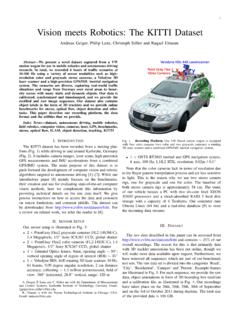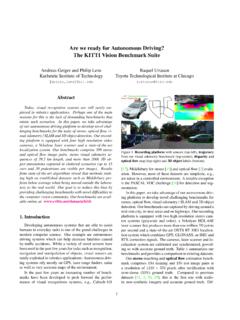Transcription of SphereNet: Learning Spherical Representations ... - cvlibs.net
1 SphereNet: Learning Spherical Representations for Detection and Classification in Omnidirectional Images Benjamin Coors1,3 , Alexandru Paul Condurache2,3 , and Andreas Geiger1. 1. Autonomous Vision Group, MPI for Intelligent Systems and University of T ubingen 2. Institute for Signal Processing, University of L ubeck 3. Robert Bosch GmbH. Abstract. Omnidirectional cameras offer great benefits over classical cameras wherever a wide field of view is essential, such as in virtual reality applications or in autonomous robots. Unfortunately, standard convolutional neural networks are not well suited for this scenario as the natural projection surface is a sphere which cannot be unwrapped to a plane without introducing significant distortions, particularly in the polar regions. In this work, we present SphereNet, a novel deep Learning framework which encodes invariance against such distortions ex- plicitly into convolutional neural networks.
2 Towards this goal, SphereNet adapts the sampling locations of the convolutional filters, effectively reversing distor- tions, and wraps the filters around the sphere. By building on regular convolu- tions, SphereNet enables the transfer of existing perspective convolutional neural network models to the omnidirectional case. We demonstrate the effectiveness of our method on the tasks of image classification and object detection, exploiting two newly created semi-synthetic and real-world omnidirectional datasets. 1 Introduction Over the last years, omnidirectional imaging devices have gained in popularity due to their wide field of view and their widespread applications ranging from virtual reality to robotics [10,16,21,27,28]. Today, omnidirectional action cameras are available at an affordable price and 360 viewers are integrated into social media platforms.
3 Given the growing amount of Spherical imagery, there is an increasing interest in computer vision models which are optimized for this kind of data. The most popular representation of 360 images is the equirectangular projection where latitude and longitude of the Spherical image are mapped to horizontal and ver- tical grid coordinates, see Figs. 1+2 for an illustration. However, the equirectangular image representation suffers from heavy distortions in the polar regions which implies that an object will appear differently depending on its latitudinal position. This presents a challenge to modern computer vision algorithms, such as convolutional neural net- works (CNNs) which are the state-of-the-art solution to many computer vision tasks. While CNNs are capable of Learning invariances to common object transformations and intra-class variations, they would require significantly more parameters, training samples and training time to learn invariance to these distortions from data.
4 This is un- desirable as data annotation is time-consuming and annotated omnidirectional datasets 2 Benjamin Coors, Alexandru Paul Condurache, Andreas Geiger (a) 360 Cameras (b) 360 Image (c) Regular Kernel (d) SphereNet Kernel Fig. 1: Overview. (a+b) Capturing images with fisheye or 360 action camera results in images which are best represented on the sphere. (c) Using regular convolutions ( , with 3 3 filter kernels) on the rectified equirectangular representation (see Fig. 2b). suffers from distortions of the sampling locations (red) close to the poles. (d) In contrast, our SphereNet kernel exploits projections (red) of the sampling pattern on the tangent plane (blue), yielding filter outputs which are invariant to latitudinal rotations. are scarce and smaller in size than those collected for the perspective case. An attrac- tive alternative is therefore to encode invariance to geometric transformations directly into a CNN, which has been proven highly efficient in reducing the number of model parameters as well as the required number of training samples [4, 29].
5 In this work, we present SphereNet, a novel framework for processing omnidirec- tional images with convolutional neural networks by encoding distortion invariance into the architecture of CNNs. SphereNet adjusts the sampling grid locations of the convolu- tional filters based on the geometry of the Spherical image representation, thus avoiding distortions as illustrated in Figs. 1+2. The SphereNet framework applies to a large num- ber of projection models including perspective, wide-angle, fisheye and omnidirectional projection. As SphereNet builds on regular convolutional filters, it naturally enables the transfer of CNNs between different image Representations by adapting the sampling locations of the convolution kernels. We demonstrate this by training object detectors on perspective images and transferring them to omnidirectional inputs. We provide ex- tensive experiments on semi-synthetic as well as real-world datasets which demonstrate the effectiveness of the proposed approach for image classification and object detection.
6 In summary, this paper makes the following contributions: We introduce SphereNet, a framework for Learning Spherical image Representations by encoding distortion invariance into convolutional filters. SphereNet retains the original Spherical image connectivity and, by building on regular convolutions, en- ables the transfer of perspective CNN models to omnidirectional inputs. We improve the computational efficiency of SphereNet using an approximately uni- form sampling of the sphere which avoids oversampling in the polar regions. We create two novel semi-synthetic and real-world datasets for object detection in omnidirectional images. We demonstrate improved performance as well as SphereNet's transfer Learning capabilities on the tasks of image classification and object detection and compare our results to several state-of-the-art baselines. SphereNet: Learning Spherical Representations in Omnidirectional Images 3.
7 2 Related Work There are few deep neural network architectures specifically designed to operate on omnidirectional inputs. In this section, we review the most related approaches. Khasanova et al. [14] propose a graph-based approach for omnidirectional image classification. They represent equirectangular images using a weighted graph, where each image pixel is a vertex and the weights are designed to minimize the difference between filter responses at different image locations. This graph structure is processed by a graph convolutional network, which is invariant to rotations and translations [15]. While a graph representation solves the problem of discontinuities at the borders of an equirectangular image, graph convolutional networks are limited to small graphs and image resolutions (50 50 pixels in [15]) and have not yet demonstrated recognition performance comparable to regular CNNs on more challenging datasets.
8 In contrast, our method builds on regular convolutions, which offer state-of-the-art performance for many computer vision tasks, while also retaining the Spherical image connectivity. In concurrent work, Cohen et al. [3] propose to use Spherical CNNs for classification and encode rotation equivariance into the network. However, often full rotation invari- ance is not desirable: similar to regular images, 360 images are mostly captured in one dominant orientation ( , it is rare that the camera is flipped upside-down). Incorporat- ing full rotation invariance in such scenarios reduces discriminative power as evidenced by our experiments. Furthermore, unlike our work which builds on regular convolutions and is compatible with modern CNN architectures, it is non-trivial to integrate either graph or Spherical convolutions into network architectures for more complex computer vision tasks like object detection.
9 In fact, no results beyond image classification are pro- vided in the literature. In contrast, our framework readily allows for adapting existing CNN architectures for object detection or other higher-level vision tasks to the omnidi- rectional case. While currently only few large omnidirectional datasets exist, there are many trained perspective CNN models available, which our method enables to transfer to any omnidirectional vision task. Su et al. [30] propose to process equirectangular images with regular convolutions by increasing the kernel size towards the polar regions. However, this adaptation of the convolutional filters is a simplistic approximation of distortions in the equirectangular representation and implies that weights can only be shared along each row, resulting in a significant increase in model parameters. Thus, this model is hard to train from scratch and kernel-wise pre-training against a trained perspective model is required.
10 In contrast, we retain weight sharing across all rows and columns so that our model can be trained directly end-to-end. At the same time, our method better approximates the distortions in equirectangular images and allows for perspective-to-omnidirectional representation transfer. One way of mitigating the problem of Learning Spherical Representations are cube map projections as considered in [19, 22]. Here, the image is mapped to the six faces of a cube which are considered as image planes of six virtual perspective cameras and processed with a regular CNN. However, this approach does not remove distortions but only minimizes their effect. Besides, additional discontinuities at the patch boundaries are introduced and post-processing may be required to combine the individual outputs 4 Benjamin Coors, Alexandru Paul Condurache, Andreas Geiger of each patch.


